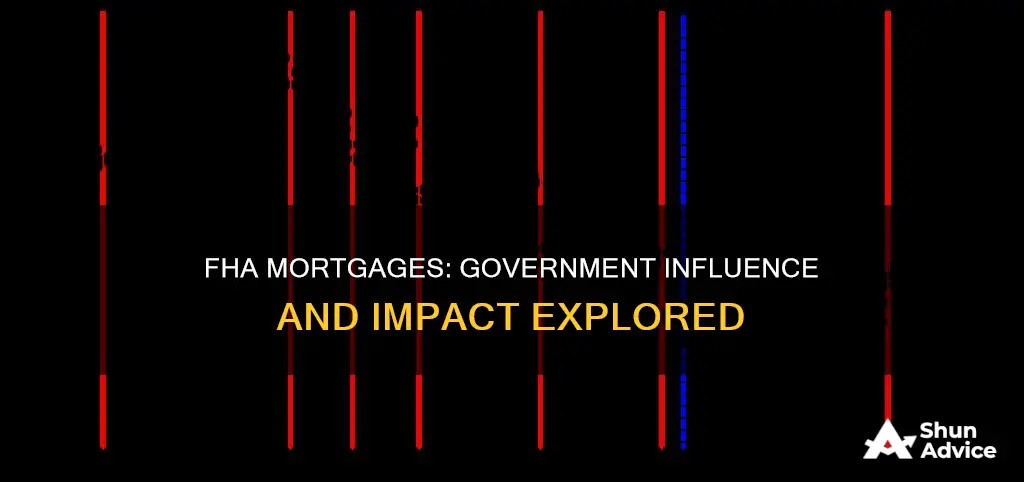
The Federal Housing Administration (FHA) is a government agency that provides insurance for mortgages issued by private lenders. FHA loans are designed to help low- to moderate-income families, particularly first-time homebuyers, attain homeownership. The FHA was established in 1934 to help stimulate the U.S. housing market and reduce the risk to lenders, making it easier for borrowers to qualify for home loans. FHA loans require a lower minimum down payment and allow for lower credit scores than conventional loans. The government's involvement in insuring these loans has had a significant impact on the housing market, increasing homeownership rates and providing assistance to specific groups such as minorities, seniors, and those in need of energy-efficient housing. However, the FHA has also been criticized for its discriminatory policies, such as redlining, which disproportionately affected minority communities.
| Characteristics | Values |
|---|---|
| Purpose | To facilitate access to reasonably priced mortgage financing, with a particular focus on individuals with low to moderate incomes and those embarking on their first home purchase |
| Function | Provide insurance for mortgages originated by private lenders for various types of properties, including single-family homes, multifamily rental properties, hospitals, and residential care facilities |
| Impact | Homeownership rates experienced a notable increase, rising from 40% in the 1930s to 61% and 65% by 1995. The peak of homeownership was nearly 69% in 2005 |
| Benefits | Helps homebuyers by insuring their loans so lenders can offer lower down payments and closing costs; offers assistance to first-time homebuyers, seniors who partially or fully own their homes, and those buying a manufactured or mobile home |
| Eligibility | Borrowers with lower credit scores and don't qualify for conventional mortgages; borrowers who can't make large down payments |
| Requirements | Mortgage insurance is required on all FHA loans, even with a 20% down payment; the home must undergo an FHA appraisal and meet government standards for health and safety |
| Discriminatory impact | Implemented mortgage underwriting standards that negatively affected minority neighborhoods; between 1945 and 1959, African Americans received less than 2% of all federally insured home loans |
What You'll Learn

The Federal Housing Administration (FHA)
The FHA was established during the Great Depression when the housing industry was in crisis. Default and foreclosure rates had skyrocketed, and the terms of mortgages were unattainable for most wage earners. As a result, only one in ten households owned their homes, and the rest were renters. The FHA was created to reduce the risk to lenders and make it easier for borrowers to qualify for home loans.
The primary mission of the FHA is to facilitate access to reasonably priced mortgage financing, with a particular focus on individuals with low to moderate incomes and those embarking on their first home purchase. The FHA loan program is designed for borrowers who cannot make large down payments, have lower credit scores, and do not qualify for conventional mortgages. FHA loans require a lower minimum down payment, starting at 3.5% with a credit score of 580, and even lower at 10% with a credit score of 500. Borrowers with FHA loans must purchase FHA mortgage insurance, which helps fund other FHA programs that benefit homeowners, renters, and communities.
The FHA has had a significant impact on the housing market in the United States. Homeownership rates have increased notably since the establishment of the FHA, rising from 40% in the 1930s to nearly 69% in 2005. The FHA has also played a crucial role in financing homes for returning white veterans and their families after World War II and in supporting financially struggling properties during periods of economic crisis. However, the FHA has also been criticized for its early discriminatory policies, such as redlining, which disproportionately affected minority neighborhoods and prevented millions of Black Americans from achieving homeownership.
Removing Deceased Spouse from Mortgage: What You Need to Know
You may want to see also

FHA loan criteria
FHA loans are available to individuals with lower credit scores than the best mortgage lenders usually require. FHA loans are designed to help low- to moderate-income families attain homeownership and are particularly popular with first-time homebuyers. FHA loans are mortgages intended for certain borrowers who might find it difficult to obtain loans otherwise. The federal government insures FHA loans issued by private lenders, such as banks. FHA borrowers must pay two types of mortgage insurance premiums (MIPs)—one upfront and the other monthly. Due to FHA insurance, banks are more willing to lend to homebuyers with low credit scores and small down payments.
To qualify for an FHA loan, the home you consider must be appraised by an FHA-approved appraiser. You can only get a new FHA loan for your primary residence, which means it can't be an investment property or second home. You must occupy the property within 60 days of closing. The loan requires an inspection, and the inspection must report whether it meets the minimum property standards.
Setting Up a Mortgage: Dependents and Their Homes
You may want to see also

FHA mortgage insurance
FHA loans are designed for borrowers who might find it challenging to obtain conventional loans due to lower credit scores and smaller down payments. The insurance reduces the risk for lenders, making them more willing to offer mortgages to these borrowers. The FHA has a maximum loan amount it will insure, known as the FHA lending limit, which is calculated based on median house prices in each county and adjusted annually.
While FHA loans offer advantages like lenient credit score requirements, low minimum down payments, and competitive interest rates, the mortgage insurance premiums are an additional cost for borrowers. These premiums are mandatory for the entire loan term in most cases, and borrowers cannot reduce the MIP amount during the loan. However, refinancing may provide an opportunity to lower the mortgage insurance payment in some circumstances.
Reporting Mortgage Insurance Premiums: A Comprehensive Guide
You may want to see also

FHA appraisal
An FHA appraisal is a standard part of the process when buying a home with an FHA loan. The appraisal establishes the value of the property and ensures it is safe for the homeowner or prospective homeowner. FHA appraisals are carried out by third-party professionals unrelated to the buyer or seller. They provide an estimate of the property's market value to ensure that lenders aren't issuing loans for more than a property is worth.
The appraisal process involves assessing the home's condition and determining its fair market value. This includes observing, analysing and reporting on the property's physical and economic characteristics. The appraiser will also look for comparable recent sales of similar properties or "comps". FHA appraisals also include basic safety inspections to ensure the property meets the minimum property standards set by the U.S. Department of Housing and Urban Development (HUD). These safety checks relate to whether the property is move-in ready, with no exposed floorboards or non-functioning utilities, which could pose health and safety issues.
FHA loans are government-backed mortgages designed to help low- to moderate-income families attain homeownership. They are particularly popular with first-time homebuyers, seniors, and those buying manufactured or mobile homes. FHA loans offer more flexible credit requirements and lower down payment options than conventional mortgages. However, FHA loans require mortgage insurance payments and may have stricter appraisal requirements, sometimes mandating repairs before loan approval. Overall, the FHA appraisal process is an important step in ensuring the suitability and safety of the property for both the buyer and the lender.
Removing a Co-Signer from Your Mortgage: A Step-by-Step Guide
You may want to see also

FHA loan limits
The Federal Housing Administration (FHA) manages the FHA loan program. It helps homebuyers by insuring their loans so that lenders can offer lower down payments and closing costs. FHA loans are mortgages intended for certain borrowers who might find it difficult to obtain loans otherwise. The federal government insures FHA loans issued by private lenders, such as banks.
FHA borrowers must pay two types of mortgage insurance premiums (MIPs)—one upfront and the other monthly. Due to FHA insurance, banks are more willing to lend to homebuyers with low credit scores and small down payments. FHA loans are designed to help low- to moderate-income families attain homeownership and are particularly popular with first-time homebuyers. FHA loans are available to everyone, including those who can afford conventional mortgages.
Finding the Best Mortgage: A Shopper's Guide
You may want to see also
Frequently asked questions
FHA stands for Federal Housing Administration, a government agency that provides insurance for mortgage loans offered by approved banks or lenders.
FHA mortgages are designed for borrowers who cannot make large down payments and have lower credit scores. They require mortgage insurance, which is not always the case with conventional mortgages. FHA mortgages are also easier to qualify for than conventional mortgages.
FHA mortgages require a lower minimum down payment than conventional mortgages, often as little as 3.5%. They also offer assistance to first-time home buyers, seniors, and those buying a manufactured or mobile home.
To qualify for an FHA mortgage, you need a credit score of at least 580 and to make a down payment of at least 3.5%. If your credit score is between 500 and 579, you will need to make a down payment of at least 10%.
To apply for an FHA loan, visit the Housing and Urban Development (HUD) website to find and contact your state housing finance agency (HFA) and learn about local homebuyer assistance programs.







